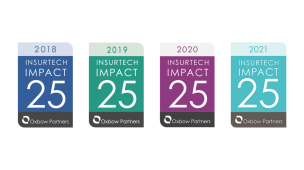Three messages from InsurTech Expo 2017
7 April, 2017 George Hanks
Last month, Oxbow Partners attended InsurTech Expo 2017, an event that brought together an eclectic mix of exhibitors and speakers, ranging from 3-month-old startups, to the incumbent insurers.
In this post, we share three messages we took away from InsurTech Expo 2017.
“There are currently 5 key areas of insurance innovation”
This is the view of Carl G. Bauer-Schlichtegroll, General Partner at EoS Venture Partners. EoS Venture Partners are a specialist InsurTech VC that have now invested in 6 InsurTech startups at the Seed stage.
- Efficiency Improvements: InsurTech is helping lower costs across the insurance value chain. For example, exhibitor RightIndem (Bitesize profile) are digitizing and automating the motor claims process, helping insurers to decrease their operating costs and improving the experience for customers
- Changing client interfaces: InsurTech is facilitating new customer touchpoints, helping insurers to improve the customer experience. For example, exhibitor Spixii (Bitesize profile) use artificial intelligence and machine learning techniques to power a chatbot to communicate with customers. Insurers can move away from form-filling to “chatting”
- Improved underwriting: New technologies are allowing insurers to improve their underwriting processes. Specifically, the use of new data sources to manage risk and new technologies to price risk (e.g. drones) are driving this innovation. Arowana apply machine learning techniques to unstructured data to generate (what they claim to be) market out-performing loss ratios. Dropin provides insurers with HD video streams from sources including drones to give insurers better insights into the objects that they will be underwriting.
- The Internet of Things: InsurTech is continuing to push innovation in both commercial and retail applications of IoT. Neos (Bitesize profile) use connected technology, such as smart smoke detectors and motion sensors to reduce the frequency and cost of claims and increase customer retention by offering a modern, differentiated proposition
- Data science: InsurTech is offering insurers the opportunity to gain much greater insight from their data and the potential to shift the entire insurance proposition from protection to prediction and prevention. No companies that fit this category exhibited at the expo, but our recent Bitesize profiles provide some examples: Tyche and Carpe Data.
“Incumbents: If you’re serious about innovation, please prepare your business”
This was the view of another EoS man – Sam Evans, Founder and General Partner. Sam argued that the way in which insurers plan on using innovative technologies varies on an almost monthly basis: there’s much talk about innovation and partnering, but little action.
One driver of this is procurement. Existing processes can stifle innovation: asking a six-man startup to navigate the same procurement process as a major IT outsourcer is a major barrier to partnership. Insurers should adopt a more agile procurement process to allow them to benefit from emerging technologies.
“25 May 2018 is an extremely important day”
Such was the view of Dharmendra Patel, Strategy and Finance Director at Pushfor. Dharmendra was referring to the day that the General Data Protection Regulation (GDPR) will be introduced.
The full extent of the GDPR was laid bare in this talk and the reactions of shock and amazement in the room could be representative of the industry’s lack of preparation. (We have a guest blog post covering the impact of GDPR coming soon – please look out for that)
Points about the GDPR highlighted by Dharmendra were:
- Customers will have the right to be forgotten. Specifically, customers can ask their insurer to delete their personal data where it is no longer required for its original purpose
- Customers can request that all personal data that an insurer holds be transferred to competitors and insurers must be able to provide evidence that they have done so
- Insurers have just 72 hours to report a data breach. Failure to comply could lead to a fine of £20m or up to 4% of turnover – whichever is greater
Dharmendra argued that the legacy systems of incumbents could pose a stumbling block to compliance. The consensus in the room was that many incumbents may not even know the extent of data that they hold on their customers.
In contrast, startups have the luxury of building their systems from scratch, and with the GDPR in mind. Without having to worry about IT change, startups can focus on doing what they do best – disrupting and innovating.



